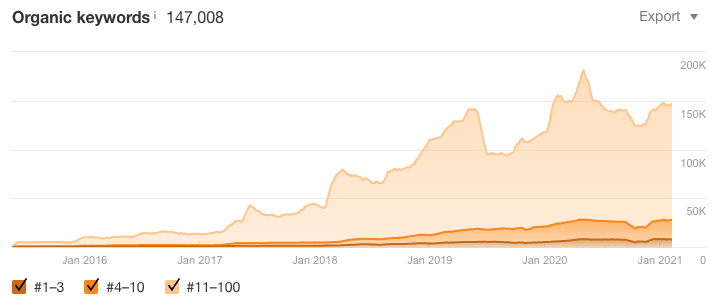How Many Blog Posts Should You Publish Every Month?
By Nicolas Jacobeus on July 30, 2021

If you’ve got a blog or are starting one for your SaaS or productized services company, you’ve no doubt considered how often to publish. Is it daily like Databox, or less than once a month like Brian Dean? Or somewhere in between?
Of course you want to start tapping into the benefits of blogging quickly. You might have a lot you want to say to customers, and you know that blog content is the backbone of your SEO efforts. If you’ve read any of the studies, it’s tempting to think that you need to blog several times a week to make an impact.
But the ideal number for you may not be the same as another company’s. This is because the number of blog posts you should aim to publish every month will depend on: 1) your blog goals, 2) how fast you want to reach those goals, and 3) the resources you have to support your blog.
Balancing these three factors will help you determine your ideal publishing frequency.
1. The purpose of your blog
The reasons you started a blog will impact how often you publish. Is your primary goal for your blog to bring in traffic passively through SEO? Then in theory you’ll want to publish more. If your goal is sales enablement and brand building, you can see the impact with fewer posts every month.
But as we’ll see below, the answer is not always so clear-cut.
If SEO is your goal
Generally speaking, the more you publish, the better results you’ll see from your blog when it comes to SEO. But what do we mean by “more”? For some, that means publishing more frequently. For others, it means publishing bigger blog posts. Let’s look at a couple of examples.
Databox publishes its blog daily, with a team of three full-time staff and five freelancers. The blog grew from just over 1K keywords in 2017 to nearly 90K four years later, Orbit Media tells us.

On the other hand, SEO expert Brian Dean from Backlinko is well-known for growing his traffic by posting less frequently than others in his industry. He only published 53 blog posts in five years, yet he was able to grow his share of Google’s search results by staggering numbers.

How could he attract almost 11 million page views with only 53 blog posts? Instead of churning out a lot of content like, say, Moz, he put a huge amount of effort into each post — 20 hours — and spent on average 10 hours promoting the content after publication. In his words, he goes “an inch wide and a mile deep” in each post.
So, we can see that both approaches work for capturing SEO traffic: publish many separate blog posts as frequently as you can, or publish fewer, more in-depth blog posts less frequently.
Whichever you choose, it’s clear that you still need a lot of content to bring in SEO results.
If supporting other sales channels is your goal
SEO-focused content helps build awareness and generate traffic, but as you can see from the charts above, that takes time. You might find that putting your attention further down the funnel will make more sense for your company right now.
You can construct blog topic ideas to address the questions your customers have rather than basing your content planning on keyword research. These sales-focused topics may have low search volumes but will prove extremely useful because they help your target customers make decisions once they arrive on your website.
Take for example the content agency Animalz, which focused exclusively on sales topics in its blog for the first few years. The company relied on its blog to support its sales funnel, publishing only 2-3 times per month and doubling employees to almost 60 within two years.
Companies using this approach may not need to publish as frequently as those who are wishing to build SEO results quickly. Yes, sales enablement posts can also help bring traffic via SEO in the long term, thanks to incidental use of long-tail keywords, but it will happen more slowly.
Instead, you will look to the impact on your sales efforts. Are prospects engaging with your blog posts, clicking through to read more from your emails, or signing up to your email list once you get them on your site? Early measures like these will be more important to you than traffic numbers if your focus is sales support rather than SEO.
2. How fast you want to see results
Want to see results faster? Publish faster. HubSpot found a positive correlation between the number of pages a website has indexed in Google and the number of leads you receive. They say that once you hit 300 pages, you can expect a big bump in traffic. Somewhere between 24 and 51 posts you may begin to see a steady increase.
Neil Patel, one of the internet’s best-known blogging and SEO experts, also discovered years ago that he could increase traffic by publishing more frequently. He experimented with publishing two posts a month rather than one and noted his traffic jumped quickly from 46K to 60K. Publishing content faster helped him reach 100K/month in less than a year.
The catch is that higher frequency must not come at the expense of quality. This means it’s not enough to simply publish more frequently. You need to continue to produce top-notch content in every blog post.
And publishing great material more frequently will require you to also speed up your investment in your content.
3. Your resources
You must balance your frequency and goals with the resources you can invest in blogging.
For instance, Marketing Insider Group pinpoints 11 posts a month as the sweet spot for most businesses that want to increase traffic through SEO. But that number doesn’t take into account the differences from one blog to another, such as lifecycle stage — it simply isn’t realistic for many newer blogs. A too-aggressive publishing schedule for your blog can steal resources from activities that may need them more at the current stage of your business.
And if you’re just getting started, there are some important things to work out for your blog before it makes sense to publish multiple times a week.
We usually recommend you start out with two to four posts per month if you’re just beginning to invest in your blog. This way, you can begin to build an SEO foundation while getting to know what your customers want to read from you. Taking it slow to start also lets you fully appreciate your strengths and weaknesses when it comes to blogging, so you can tweak your strategy and decide what to outsource to an agency and what to keep in-house.
Then when you’re ready to see the returns that increased posting can bring, you’ll have a solid foundation to build on.
As your blog grows, plan to update content, too
While increasing the frequency of your posting schedule can have a big impact, it’s also important to keep old posts up to date.
HubSpot notes that, on top of posting a few times every month, you should aim to update content in a few old posts. In other words, when you publish a blog post, you should think of it as the beginning of the post’s journey. Each time you publish an update, you’ll improve the post’s chance of success, while giving your overall SEO a boost.
Discover SaaSpirin’s blog packages and start transforming your blog with our team of experienced strategists, writers, and editors today.
You May Also Like
These Related Stories

4 Things You Should Be Doing to Vet Your Blog Post Ideas

Content Marketing Success Takes Hard Work—Here's What You Have to Do (A Checklist)

